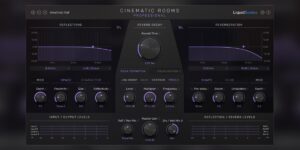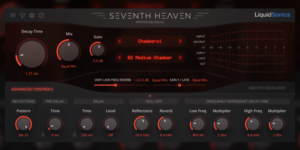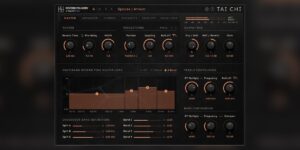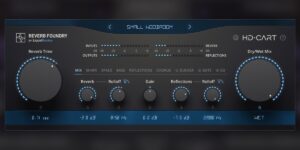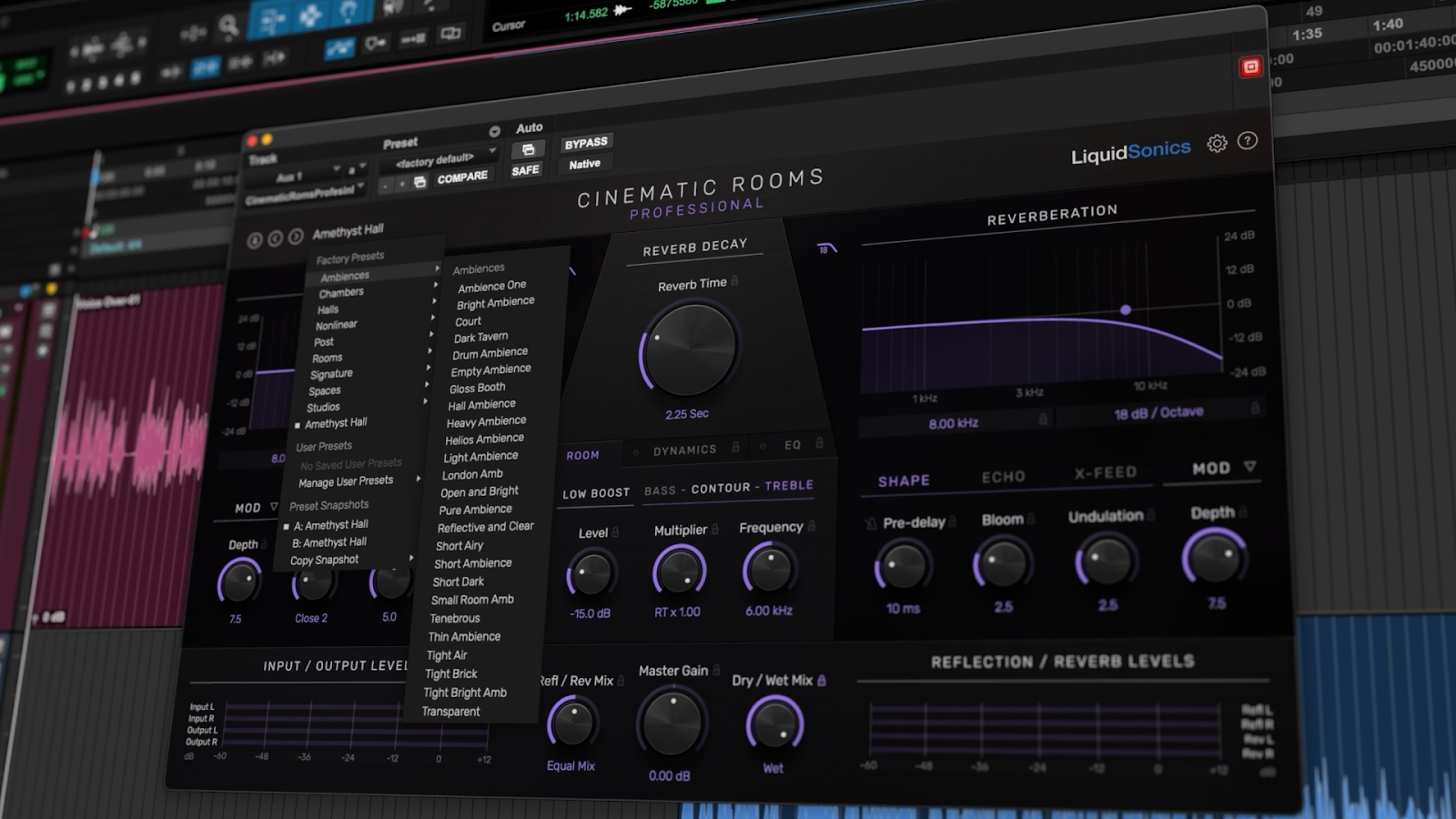
We Asked Professional Engineers What LiquidSonics Reverb Plugin Presets They Use
When you have a choice of five Atmos-compatible plugins from the LiquidSonics reverb range, the options can seem overwhelming. With such a broad palette of sonic possibilities at your fingertips, where do you even start? We spoke to several professional musicians, engineers, and mixers to find out which their favourite presets are, offering you a useful guide to navigate these powerful plugins.
In this article we’ll also share some of their pro producer tips and tricks, and sneak in a few little development secrets too! You’ll discover the back story about one fan-favourite Cinematic Rooms preset that has been honed to perfection, why HD Cart is perfect for solo leads, and how the M7 v1 and v2 preset banks became so distinctive. Read on to learn more…
Scott Michael Smith
Score Mixer
Scott Michael Smith is a two-time Grammy Award-winning Mixer, Producer and multi-instrumentalist. Based in Los Angeles, he now records in many of the world’s finest establishments and is very familiar with the world’s best recording stages. Scott’s early years in records saw him working with various artists, from John Mayer to Katy Perry, Weezer, Carole King and many more.
Nowadays, as a highly in demand score mixer, Scott has recorded and mixed blockbuster scores for some of Hollywood’s biggest films and TV shows, including The Revenant, The Handmaid’s Tale, Mank with Trent Reznor and Atticus Ross, It Chapter 2, Moon Knight and Shazam!
Cinematic Rooms is often his plugin of choice. Scott has his own ‘Go To Hall’ preset based on Amethyst Hall but with a rolled-off top and a shorter tail, he says “Amethyst Hall achieves this perfect balance of being dense and full but never getting in the way, always musical. In a lot of ways, it reminds me of Abbey Road Studio 1”.
In case you missed it, we recently interviewed Scott to find out more about his career and how it feels to mix a hit Star Wars show for Disney+!
Doug Mountain
Supervising Sound Editor/Re-recording Engineer
Doug is currently a Supervising Sound Editor and Rerecording Mixer for Warner Brother Post Production Service at the Warner Brother Studios in Burbank California. He currently manages all the upmixes for the 4K Restorations in Atmos for the studio. He has recently developed a methodology for restoring and upmixing classic features into Atmos.
In recent years Doug has had a successful career Sound Editing and Engineering and has worked on such notable projects such as The Walking Dead (AMC), Breaking Bad (AMC), Fear the Walking Dead (AMC), Flight Attendant (HBO), Community (NBC) and Super 8 (Paramount). He received an Emmy nomination for his work on Catch-22.
Cinematic Rooms is his plug-in of choice. “I really love this reverb when mixing in Atmos. It gently fills the space in a very three dimensional way. I use the Room Next Door post preset for most all my off screen effects. For outdoor scenes I love the Large Outdoor preset. A few simple adjustment and it’s easily shaped most scenes.”
George Shilling
Music Producer & Mixer
George is a recording engineer, producer and musician. He now works mostly from his own studio in Newton Abbot, Devon. Shilling has worked with various musical genres, including artists such as Gabrielle, New Radicals, The Corrs, Blur, Oasis, James Brown, Steve Winwood and the popular light opera duo Operababes.
Wood room presets are a staple of reverb culture and George swears by Seventh Heaven‘s Large Wooden preset under the Rooms 1 category, rarely even finding the need to tweak any settings! He says, “Just sounds really natural for a bit of air around anything. Rarely adjust any settings. It just sounds great!”
Andy Bradfield
Producer & Score Mixer
Andy is a freelance mixer and producer based in London. Andy started his career in London’s Olympic and Townhouse Studios before going freelance and moving into production and mixing. His work includes musical projects with Elbow and Rufus Wainwright; his film projects have included Snowden, Kick-Ass and Moulin Rouge.
According to Andy, the choice largely depends on what you want the reverb to accomplish. His initial response to the question was, “This is impossible to give a short answer to! There are so many great presets to start from, and they are all very adaptable – like big box hardware used to do!!” However, we pressed him…
Cinematic Rooms: He uses London Hall for a more diffuse/distant effect and Amethyst Hall for something brighter/closer. He also gets a lot of use out of ‘Gallery’ and ‘Full Chamber’.
Lustrous Plates: His favourite plate model is Rhodium Plate – it has a very bright and rich timbre, with a very neutral decay profile so it’s ideal for a wide range of applications from drums to vocals. Check it out if you’re looking for a good general purpose plate reverb.
Seventh Heaven: Large Hall and Plates—Dark Plate are his favourites from our lauded Bricasti M7 reproduction.
HD Cart: Light Sax Hall and and Bright Chamber came out top!
James Richmond
Composer
James is a British-Australian composer, music producer, educator, and multi-instrumentalist. James works in rural Oxfordshire from his recording studio, Volt Per Octave. As a multi-instrumentalist, he performs as a guitarist, bassist, and drummer, often incorporating modular synthesisers, custom-built electronic instruments featuring Arduino micro-controllers, and Max by Cycling ’74.
James works with three LiquidSonics plugins—Seventh Heaven, Cinematic Rooms, and Reverberate 3.
Seventh Heaven: James prefers the V1 algorithms, which he finds to be more Bricasti-like – it’s no surprise, the V1s are all from the hardware’s original design which established the hardware as a modern masterpiece. The V2s were added later to accommodate requests for brighter and more highly modulated like reverbs as some clients were so familiar with the likes of the Lexicon 480.
James’ go-to presets are Plates1 / Snare Plate A&B, and for Chambers and Rooms he simply picks the preset named ‘Medium’ for both. He also occasionally uses ‘Adjacent Floor’ for special effects from the Interiors bank. These are a very special collection designed by the M7’s original hardware designer at Todd-AO, they are particularly useful for dialog/FX and other post production workflows.
Cinematic Rooms: James relies on Tight Room A/B/C/D, Studio Hall, Large Hall, and Rich Long Hall. Although he often lowers the reverb time and saves his adjustments.
Reverberate 3: Bright Hall, Classic Room, and Reverse Drum Room are his picks here, again usually adjusting the reverb time.
James tends to prefer a shorter reverb, telling us; “I tend to lower the reverb time for most of them and save them as my own version.”
Simone Coen
Audio Engineer & Producer
Simone Coen is an audio engineer and producer based in Seregno, Northern Italy. He has a prolific record working in music, film and music for advertising. He had worked on diverse projects for brands such as Alfa Romeo, Müller Yoghurt, Volvo, and BMW. His musical credits include Mario Lavezzi, Giorgia, Sergio Dalma, Simone Bertolotti, Ferdinando Arnò, Silvia Cecchetti. Since 2009 he has been a contract professor in Audio Restoration at the Università Statale di Milano.
Simone has an extensive list of favoured presets across multiple LiquidSonics plugins, each serving a specific purpose.
Seventh Heaven Professional: Simone particularly likes the Sunset Chamber and Vocal Chamber presets, citing that they encapsulate the reverberation chamber effect very well. He says; “They’re characterful but manage to avoid overwhelming the mix.” – these are absolute classic presets, a great many producers jump straight to these or even leave their M7s permanently running them for every session they do! With over 200 presets in this professional powerhouse of course it’s not always clear where to start, so if you’re not sure where to begin this is a good place to be.
Cinematic Rooms Professional: His default pick here is Amethyst Hall, which was the first preset he ever used. He finds it to work exceptionally well with musical material, describing it as ‘spacey’ but never annoying.
This is a good opportunity to pull back the developer’s curtain a little. From the very beginning Amethyst Hall was a fundamental part of the Cinematic Rooms story because it is the genesis preset. Months before the graphics were sketched and sent to our talented designer Sasha or a single preset saved to disk for the final package, the core reverb algorithm was tuned using these base settings. What was eventually named Amethyst Hall had been in use for countless hours; listening, refining and finessing – to get the sound of the reverb itself just right! It is only fitting that it is also the first preset that everybody else hears when loading up Cinematic Rooms for the first time too.
Lustrous Plates: Platinum Plate is Simone’s choice when he wants a reverb that’s platey and roomy simultaneously. He finds it particularly useful for reinforcing a drum room or even close-miked drums.
Reverberate 3: While Simone often uses his own Impulse Responses (IRs), he does rely on Small Halls from the FS91 Live Bank. Despite its name, he finds it sounds large and active, making it an ideal choice when you want a bold reverb presence.
Tai Chi: This reverb is a dream for electronic music, and Simone has developed his own preset called Electronic Beat Place, which he says “infuses life into dead synthetic drums and percussive or sequencer parts.” You’ll find it in the signature artist bank of the reverb’s factory presets if you want to check it out for yourself.
HD Cart: Due to its heritage as a concert hall augmentation algorithm, it is perhaps no surprise that Lead Solo is Simone’s go-to preset for positioning solo parts effectively within a mix.
Nuno Filipe Fernandes
Engineer and Mixer
Nuno trained at Berklee College of Music in Boston, and after living in LA and working at the American Music Awards and the GRAMMYs, he moved to London in late 2011 and back home to Portugal in the summer of 2018. He has worked with Bryan Adams, Jeff Lynne, Procol Harum, KT Tunstall, Pete Brown and Phil Ryan, Curved Air, London Grammar and more.
In a recent mix, Nuno used a blend of Tai Chi, Cinematic Rooms Pro‘s Amethyst Hall, Seventh Heaven Pro‘s Boston Hall A, and HD Cart‘s Vocal Cavern, often customising them to taste.
His advice; “I love just selecting the type of reverb from the arsenal and then just browsing the presets and playing with them.” – and with so many to choose from, there’s an almost limitless supply of reverb bliss to indulge in!
Žiga Rezar
Engineer & Mixer
Žiga Rezar is a former musician of numerous heavy rock/metal bands in Slovenia, including Inmate, Naio Ssaion, and Dustin Chambers. He then spent several years working for Slovenian national TV and Radio. Now based in Cologne, Germany, he works as a mixing engineer and audio DSP developer.
For Žiga, the Traditional -> Theatres presets in Reverberate 3 seem to work exceptionally well. He often finds himself using Clean Theatre, Deep Theatre, and Backstage, especially on vocals or lead elements.
He is a big fan of how well Reverberate 3 handles the IRs; “For some reason, these old school non-fusion IRs simply work in far more contexts than they should, especially on vocals or other front-and-centre lead elements. I love the M7 library as well, but with no particular favourites, I simply try ten presets from the general category that I want, and one will almost inevitably work well.” – Great advice, of course the M7 is one of those rare beasts that sounds wonderful on every preset!
Presets – Just Getting Started
It’s intriguing diving into the preferences of these professionals from around the world, and coming from such diverse backgrounds. Their answers demonstrate the versatility of LiquidSonics plugins. Our intention has always been to offer a rich palette with our plugins and a varied set of options that can be adapted to suit various mixing needs—adding depth to vocals, achieving a particular atmospheric quality, or providing a unique sonic character to instruments. The pros often have their tried-and-true starting points, but it’s also clear that they make subtle (or sometimes not-so-subtle) tweaks to make the presets their own.
The beauty of LiquidSonics reverbs lies not just in their best-in-class sound but also in their adaptability. We include features we hope invite you to get hands-on with, encouraging you to shape the sound to your specifications.
So, while the advice and presets favoured by these experts can serve as an excellent starting point, don’t hesitate to dive in and experiment. After all, the beauty of a preset is if you don’t like what you end up creating, you can always start again!
Try LiquidSonics Reverbs For Yourself
All of the LiquidSonics reverbs are available to try for free for 14 days, just head to our demos page to drop a code into your license manager and pick up the installers from the downloads page.

